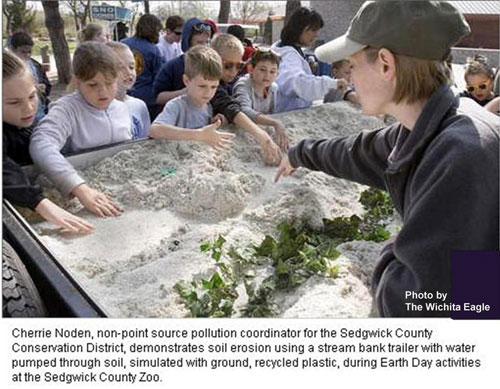Streambank Erosion Traveling Educational Demonstrations
Many Kansas streams are seriously degraded or threatened and landowners typically lack appreciation of the problem and the basic knowledge and information needed to prevent further damage. Many landowners also have misconceived ideas that work against their own interests, those of their downstream neighbors, and the larger rural ecosystem.
The Sedgwick County Conservation District can teach you about stream resources and stewardship practices with a system of four trailer-mounted stream hydrology models and a curriculum.
Get your hands wet learning about streams.
Build your own streams and experiment with riparian vegetation, straightening channels, and natural and human impacts on watersheds. This hands-on activity is fun and informative for all ages.

Audiences can observe normal and abnormal stream processes as they experiment with riparian vegetation, straightening channels, and natural and human impacts on watersheds. “What-if” scenarios provide quick and dramatic illustrations of the long-term effects of various practices.
The Stream Model Trailer simulates surface water flow and its energies; how changes upstream affect the watercourse and streambanks downstream. Topics addressed include:
- Stream Dynamics
- Streambank Erosion & Stabilization
- Channelization
- Sedimentation
The importance of wetland and riparian areas, through streambank protection and water quality, is demonstrated.
Demonstration Lessons:
“Vegetation - It’s Doing a Job” – Plastic plants simulate root networks and protect the banks from erosion. The effects of removing the “vegetation” can be seen in areas without the plastic screening.
“Flooding is Natural” – Educates people that flooding is a natural and necessary process common to nearly every stream and river in the country.
“Rivers Never Run Straight” – Educates the public about the consequences of channel straightening and why it does not work. This lesson can be used to show ‘neighbor versus neighbor’ scenarios, which demonstrates how actions on your land can affect your neighbor’s land.
“Sediment - Too Much is Bad” – This lesson demonstrates the effects of too much sediment in a stream. The lesson is set up to show the formation of point and mid-channel bars and their relation to stream erosion, as well as how sediment size affects habitat quality. The use of BMPs is also incorporated into this lesson to demonstrate their effectiveness in reducing the amount of sediment that reaches a stream.
The Conservation District staff and the Streambank Erosion Trailer are available for public education events throughout Sedgwick County.
